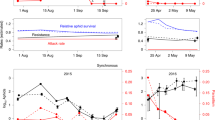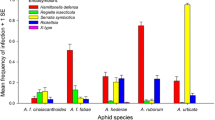Abstract
Biodiversity has both intraspecific and interspecific components, and speciation is the process through which the former is converted to the latter. Ecological factors can cause population divergence and differentiation. In this paper, we investigate the interplay between top-down effects from natural enemies and bottom-up effects from host plants in an aphid model system. Pea aphids, Acyrthosiphon pisum, are known to form host-adapted races on Trifolium and Medicago. Here, replicate clones of pea aphids collected from a broader set of five host plant genera are screened for their performance on the same set of host plants and also for their resistance to four natural enemies: the parasitoids Aphidius eadyi and Aphidius ervi, and the entomopathogenic fungi Pandora (=Erynia) neoaphidis and Zoophthora phalloides. The populations showed clear adaptation to their host plant from which they were collected, but they also performed well on Vicia. Performance on the other three plant species was poor. The aphid population collected from Lotus was significantly better at defending itself against the parasitoid A. eadyi, and there was a tendency for the clones from Trifolium to be resistant to the pathogen P. neoaphidis. These patterns highlight the importance of understanding the ecological processes influencing speciation in the context of the web of ecological adaptations within which a species is embedded.





Similar content being viewed by others
References
Baudoin M (1975) Host castration as a parasitic strategy. Evolution 29:335–352
Caillaud MC, Via S (2000) Specialized feeding behavior influences both ecological specialization and assortative mating in sympatric host races of pea aphids. Am Nat 156:606–621
Douglas AE (1998) Nutritional interactions in insect-microbial symbioses: aphids and their symbiotic bacteria Buchnera. Annu Rev Entomol 43:17–37
Eastop VF (1971) Keys for the identification of Acyrthosiphon (Hemiptera: Aphididae). Bull Br Mus nat Hist (Ent) 26:1–115
Feder JL (1998) The apple maggot fly, Rhagoletis pomonella: flies in the face of conventional wisdom. In: Howard DJ, Berlocher SH (eds) Endless forms species and speciation. Oxford University Press, New York, pp 130–144
Fellowes MDE, Kraaijeveld AR, Godfray HCJ (1998) Trade-off associated with selection for increased ability to resist parasitoid attack in Drosophila melanogaster. Proc R Soc London Ser B Biol Sci 265:1553–1558
Ferrari J, Godfray HCJ (2003) Resistance to a fungal pathogen and host plant specialization in the pea aphid. Ecol Lett 6:111–118
Ferrari J, Müller CB, Kraaijeveld AR, Godfray HCJ (2001) Clonal variation and covariation in aphid resistance to parasitoids and a pathogen. Evolution 55:1805–1814
Ferrari J, Darby AC, Daniell TJ, Godfray HCJ, Douglas AE (2004) Linking the bacterial community in pea aphids with host-plant use and natural enemy resistance. Ecol Entomol 29:60–65
Gwynn DM, Callaghan A, Gorham J, Walters KFA, Fellowes MDE (2005) Resistance is costly: trade-offs between immunity, fecundity and survival in the pea aphid. Proc R Soc London Ser B Biol Sci 272:1803–1808
Hawthorne DJ, Via S (2001) Genetic linkage of ecological specialization and reproductive isolation in pea aphids. Nature 412:904–907
Heie OE (1994) The Aphidoidea (Hemiptera) of Fennoscandia and Denmark. V.E.J. Brill, Leiden
Henter HJ, Via S (1995) The potential for coevolution in a host-parasitoid system. 1. Genetic variation within an aphid population in susceptibility to a parasitic wasp. Evolution 49:427–438
Hufbauer RA, Via S (1999) Evolution of an aphid–parasitoid interaction: variation in resistance to parasitism among aphid populations specialized on different plants. Evolution 53:1435–1445
Kraaijeveld AR, Godfray HCJ (1997) Trade-off between parasitoid resistance and larval competitive ability in Drosophila melanogaster. Nature 389:278–280
Leonardo TE (2004) Removal of a specialization-associated symbiont does not affect aphid fitness. Ecol Lett 7:461
Leonardo TE, Muiru GT (2003) Facultative symbionts are associated with host plant specialization in pea aphid populations. Proc R Soc London Ser B Biol Sci 29:61–65
McPhail JD (1992) Ecology and evolution of sympatric sticklebacks (Gasterosteus) – evidence for a species pair in Paxton Lake, Texada Island, British Columbia. Can J Zool Rev Can Zool 70:361–369
Milner RJ (1982) On the occurrence of pea aphids, Acyrthosiphon pisum, resistant to isolates of the fungal pathogen Erynia neoaphidis. Entomol Exp Appl 32:23–27
Milner RJ (1985) Distribution in time and space of resistance to the pathogenic fungus Erynia neoaphidis in the pea aphid Acyrthosiphon pisum. Entomol Exp Appl 37:235–240
Moran NA, Russell JA, Koga R, Fukatsu T (2005) Evolutionary relationships of three new species of Enterobacteriaceae living as symbionts of aphids and other insects. Appl Environ Microbiol 71:3302–3310
Nosil P (2004) Reproductive isolation caused by visual predation on migrants between divergent environments. Proc R Soc London Ser B Biol Sci 271:1521–1528
Oliver KM, Russell JA, Moran NA, Hunter MS (2003) Facultative bacterial symbionts in aphids confer resistance to parasitic wasps. Proc Natl Acad Sci USA 100:1803–1807
Polaszek A (1986) The effects of two species of hymenopterous parasitoid on the reproductive system of the pea aphid, Acyrthosiphon pisum. Entomol Exp Appl 40:285–292
Reimchen TE (1980) Spine deficiency and polymorphism in a population of Gasterosteus aculeatus – an adaptation to predators. Can J Zool Rev Can Zool 58:1232–1244
Rundle HD, Nosil P (2005) Ecological speciation. Ecol Lett 8:336–352
Rundle HD, Vamosi SM, Schluter D (2003) Experimental test of predation’s effect on divergent selection during character displacement in sticklebacks. Proc Natl Acad Sci USA 100:14943–14948
Sandström J (1996) Temporal changes in host adaptation in the pea aphid, Acyrthosiphon pisum. Ecol Entomol 21:56–62
Sandström J, Pettersson J (1994) Amino acid composition of phloem sap and the relation to intraspecific variation in pea aphid (Acyrthosiphon pisum) performance. J Insect Physiol 40:947–955
Schluter D (1994) Experimental evidence that competition promotes divergence in adaptive radiation. Science 266:798–801
Schluter D (2001) Ecology and the origin of species. Trends Ecol Evol 16:372–380
Schluter D (2003) Frequency dependent natural selection during character displacement in sticklebacks. Evolution 57:1142–1150
Simon JC, Carré S, Boutin M, Prunier-Leterme N, Sabater-Muñoz B, Latorre A, Bournoville R (2003) Host-based divergence in populations of the pea aphid: insights from nuclear markers and the prevalence of facultative symbionts. Proc R Soc London Ser B Biol Sci 270:1703–1712
Tsuchida T, Koga R, Fukatsu T (2004) Host plant specialization governed by facultative symbiont. Science 303:1989–1989
Via S (1991) The genetic structure of host plant adaptation in a spatial patchwork – demographic variability among reciprocally transplanted pea aphid clones. Evolution 45:827–852
Via S (1999) Reproductive isolation between sympatric races of pea aphids. I. Gene flow restriction and habitat choice. Evolution 53:1446–1457
Via S (2001) Sympatric speciation in animals: the ugly duckling grows up. Trends Ecol Evol 16:381–390
Via S, Hawthorne DJ (2005) Back to the future: genetic correlations, adaptation and speciation. Genetica 123:147–156
Via S, Bouck AC, Skillman S (2000) Reproductive isolation between divergent races of pea aphids on two hosts. II. Selection against migrants and hybrids in the parental environments. Evolution 54:1626–1637
Acknowledgements
We would like to thank S. Luzac and J. Toivonen for technical assistance, and D. Hawthorne, A. Kraaijeveld, C. Scarborough, F. van Veen and S. Via for helpful discussions.
Author information
Authors and Affiliations
Corresponding author
About this article
Cite this article
Ferrari, J., Godfray, H.C.J. The maintenance of intraspecific biodiversity: the interplay of selection on resource use and on natural enemy resistance in the pea aphid. Ecol Res 21, 9–16 (2006). https://doi.org/10.1007/s11284-005-0136-8
Received:
Accepted:
Published:
Issue Date:
DOI: https://doi.org/10.1007/s11284-005-0136-8




